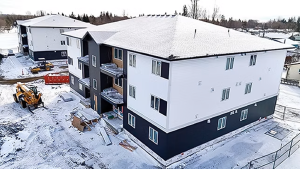The County of Essex, Ont. has teamed up with Windsor’s Becker Engineering Group to design and build what’s believed to be Canada’s first heated bridge using in part geothermal energy.
WINDSOR, Ont.
The County of Essex, Ont. has teamed up with Windsor’s Becker Engineering Group to design and build what’s believed to be Canada’s first heated bridge using in part geothermal energy.
It has won the P.J. Marshall Award from the Association of Municipalities of Ontario for demonstrating leadership in public-private partnerships.
Since the bridge crosses a provincially-significant wetland it “gave us an opportunity” to try a new technology that would hopefully limit the use of road salt, county engineer Tom Bateman says.
The bridge, located along County Rd 23 and now headed into its third winter of use, combines a number of existing technologies to draw heat from the surrounding ground and warm the bridge to prevent black ice from developing, as well as to constrain bridge contraction and expansion.
Jim Hrycay, president of Becker affiliate Hrycay Consulting Engineers, credited Group president Dr. Norbert Becker as “the lead innovator” among the companies, with “always thinking outside the box.” The company does accident reconstruction work and is familiar with road mishaps caused by ice. “All of this sort of came together,” Hrycay says, when the County of Essex wanted a replacement span over the well-travelled north-south artery.
The reason a bridge tends to freeze more quickly than the nearby road surface is because roads are warmed from ground heat.
The Becker Group was able to transfer that heat from the ground and make the deck warmer. The technology differs from what people see at winter resorts, for example, where sidewalk snow is sometimes melted using massive boiler systems.
“We looked at whether there’s a more efficient way of doing that without relying on that huge surge of power to generate the heat,” Hrycay says.
Four-foot-diameter caissons were drilled into the ground adjacent to the stream bed. Below a depth of 10 feet, the soil temperature is between 50 and 55F. Heat is extracted from the caissons through heat exchangers as a glycol fluid is pumped through the system. The heat is transferred via closed loop three-quarter inch stainless steel pipes, embedded in the concrete deck, which weave up and down — six inches apart — across the 100-foot span. The glycol then warms the deck, melting ice and snow. Depending on the outside temperature, auxiliary flash boilers are activated to increase the glycol’s temperature, speeding the melt.
For the time being, company and municipal officials are monitoring outside temperatures and tweaking the heat exchange system so that the glycol is warmed to the correct temperatures depending on ambient conditions.
The bridge has its own little weather station, measuring wind speed, deck temperature, the glycol’s temperature and dew point. It can do algorithms to determine when to increase the speed of the heat exchange pumps or when the boilers need to be activated. This equipment is contained in a small building on the south side of the bridge – “the most compressed mechanical room you’ll ever see,” says Hrycay.
While officials make adjustments through an Internet connection the goal is to have the system work on its own. “We’re trying to see whether it will be smart enough to run itself,” says Bateman.
As for construction, the bridge was put together with mostly pre-cast concrete including the two piers, pier caps and spandrels. Besides the deck tubing, insulation was added to combat airflow under the bridge. Design-wise the spandrels are deeper than on most bridges. Typically spandrels’ bottoms end at the bridge deck. But these cover the beams. Hrycay says it’s largely for aesthetic reasons.
Officials expect that moderating the bridge temperature and the bridge’s salt-free environment will reduce freeze damage and provide a longer life span.
Hrycay says future applications could be to melt ice on accident-prone “hotspots” such as river crossings or highway overpasses, particularly in climates like southern Ontario with frequent freeze-thaw cycles.
This is green technology with no chemical byproduct affecting surrounding water or land. Says Hrycay, “It’s basically no different from what Mother Nature does when springtime comes and starts melting the snow.”










Recent Comments
comments for this post are closed